What birds can you find in the Sintra hills?
25 Aug 2023
It's almost impossible to walk through the Sintra hills without hearing the chirping of birds, a sound which lulls us to sleep and transports us (even further) into a fairytale setting.
But do you know which species give the Sintra hills this aura of enchantment? Here are some examples of the most magnificent birds you may be lucky enough to encounter.
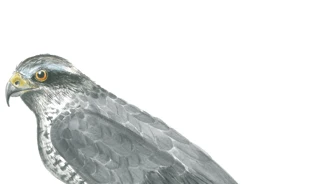
Goshawk - Accipiter gentilis
The goshawk, a medium-sized bird of prey, is typically found in areas of pine and oak forest, seeking out clearings to acrobatically hunt pigeons, starlings, partridges and rabbits.
The goshawk begins its nuptial flights between February and March, which is when it is easiest to spot. After building their nest, pairs have 3 to 4 young, staying until summer, when the first flights begin. To listen to the vocalisation of a goshawk, click here.
According to the Red Book of the Vertebrates of Portugal, published by the Institute for Nature Conservation and Forests, this species is in the 'Vulnerable' category in terms of its conservation status in Portugal.
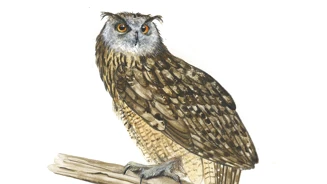
Eurasian eagle-owl - Bubo bubo
If you have the opportunity to walk in the Sintra hills at night, walk in silence and you may be lucky enough to hear this large nocturnal bird of prey. In fact, this the largest such bird in the world!
The eagle-owl begins its nesting season in December. During the winter and spring, the parents look after the young, preparing them for their first flights in early summer.
The flight of nocturnal birds of prey is silent, which makes them even more difficult to observe. Their feathers are specially adapted to not make any noise so that they can hear the movements of their prey and not scare them off with their approach. Prey for these birds are large animals such as rabbits and even foxes.
But there is one way to spot a eagle-owl: its call is different from all the others. You can hear it here. Hearing this sound at night, in the middle of the forest, immediately transports you to a world of fantasy!
According to the Red Book of Vertebrates of Portugal, this species is in the 'Near Threatened' category.
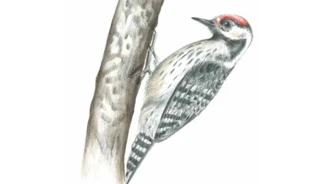
Lesser spotted woodpecker - Dendrocopus minor
Have you ever been walking in the mountains and suddenly heard repeated tapping in the trees? Almost as if someone was drilling something? And indeed someone is – the sound of the lesser spotted woodpecker tapping its beak on hollow parts of tree trunks is easily discernible. And why does it do this with its strong, pointed beak? To find insects, larvae, fruit and seeds to feed on, but also to communicate: during the breeding season, the male hits the trunks even harder to attract the attention of the female.
This is the smallest woodpecker in Europe. Combined with its discreet habits, this means that it is not easy to spot. But its drumming on hollow trunks and its high-pitched vocalisations do make it possible to detect its presence.
In addition to the lesser spotted woodpecker, the great spotted woodpecker and the green woodpecker can also be found in the Sintra hills. All three species are fortunately in the 'Least Concern' category in terms of their conservation status.
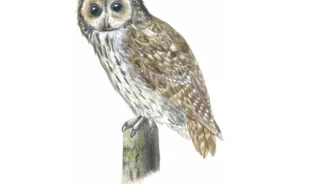
Tawny Owl - Strix aluco
If you'd like to hear a tawny owl, it's best to go for a walk in the hills during the autumn, at the end of the day or in the evening. This is the time when the males emit the most calls, a melancholy hoot that can be heard from a great distance. Listen here.
At the beginning of spring, owls lay 2 to 4 eggs in a hole in a tree trunk or in an abandoned nest – usually that of a jackdaw or another bird of prey – and defend them fiercely against anyone who comes near, including humans. During the day, they are very difficult to spot due to the colour of their plumage, which allows them to camouflage themselves among the trees of the forest.
According to the Red Book of Vertebrates of Portugal, its threat status in Portugal is 'Least Concern'.
One curious fact: did you know that tawny owls are monogamous? After choosing a mate, couples remain together until the end of their lives.
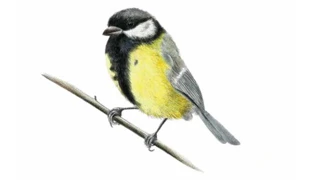
Great tit - Parus major
When we think of the birds in fairy tales, we immediately think of colourful, curious little beings with an enchanting chirp. This is the perfect description of the great tit, a species worthy of an enchanting story.
This is the largest of all the tits that exist in Portugal, but even so, it is a small bird that favours woodland, riverside and garden areas. Despite being a species that occurs all year round in Portugal, in winter the population increases with the arrival of birds from northern and central Europe.
Although it's not easy to spot in the treetops, its song attracts everyone with a repertoire of eight different melodies. Indeed, their defence of their territory depends on the quantity and complexity of their melodies, which become more audible in autumn. Listen to an example here.
These birds are often seen in pairs or groups, looking for insects or small fruits. Fortunately, the conservation status of this species in the Red Book of Vertebrates of Portugal is of 'Least Concern'.
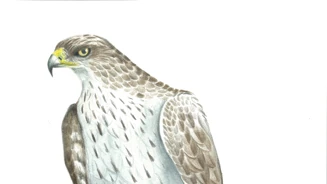
Bonelli's Eagle - Aquila fasciata
While this is probably one of the most beautiful birds found in Portugal, it is also one of the most threatened: according to the Red Book of Vertebrates of Portugal, the Bonelli's eagle is in the 'Endangered' category in terms of its conservation status in Portuguese territory.
In the Greater Lisbon area and the West region, there are only 8 to 11 pairs of Bonelli's eagles remaining. The main threat to this species is 'disturbance during the breeding season (which extends from December to June), as this species is particularly sensitive to human presence around its nests', reads the website of Life LX Aquila, a project that aims to unite local communities, authorities and experts with the common goal of protecting this eagle in the Lisbon Metropolitan Area. 'Though it once nested on the coast in Sintra, due to increased human pressure it has taken refuge in the more inaccessible forest areas of the hills, making it difficult to see,' says the book Nature in Sintra and Mafra: two forests, one unique experience.
If you are lucky enough to spot a Bonelli's eagle during your walk through Sintra, don't approach it or disturb it. To help save this species, you can become an eagle ambassador. Find more information here.
It is very difficult to spot some of these birds, but you can get to know them better at the Nature Interpretation Centre of the Park of Monserrate. Here you can discover the species that live in the Sintra hills through innovative digital resources.
